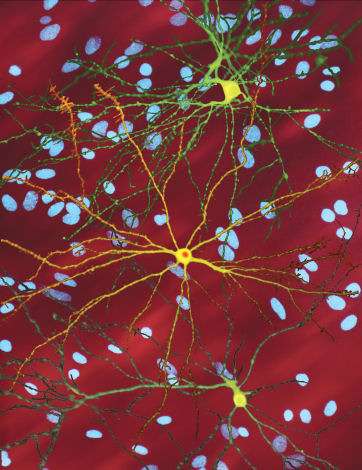Scientists find Huntington's disease mice respond differently to common infection

Casual conversation three years ago between University of Wyoming veterinary sciences and molecular biology researchers resulted in findings that show for the first time mice engineered to have the human genetic disorder Huntington's disease have an altered immune response to a common infection.
They are now seeking funding to pursue additional studies to understand how infectious processes may interact with Huntington's, which is caused by a single gene mutation.
Jonathan Fox in veterinary sciences and Jason Gigley in molecular biology exposed mice with Huntington's disease (HD) to toxoplasmosis, a common and widespread infection.
Their research found such mice die sooner and have an altered immune response. That could reveal facts about not only Huntington's, but also the interaction between infectious diseases and related neurodegenerative disorders, such as Alzheimer's, Parkinson's and prion diseases, in humans, they say.
Fox and Gigley refuse to speculate if the response they observed may be the same in humans with HD—Fox's research focus—but do say they believe they've found one factor that could contribute to the variability of when symptoms appear in humans.
That varies greatly from childhood to old age but, for most people, it's in early adult life.
"We know environmental factors contribute to the large variability in age of disease onset, but next to nothing is known about which environmental factors are involved," Fox says.
Toxoplasmosis, caused by Toxoplasma gondii, appears to make mouse HD worse.
"Importantly, this infection has high prevalence in the human population, so we think it important to investigate if T. gondii also affects human HD," he says.
A game of cat and mouse lays at least a little of the foundation for the research, and there's a good chance many reading this have a connection to the study.
Gigley is an expert in T. gondii, a parasite found worldwide in more than 30 to 50 percent of humans (and more than 60 million in the United States, according to the Centers for Disease Control and Prevention).
Research shows the parasite alters behavior of those infected in such a way to help guarantee its survival—the parasite causes mice to lose their innate fear of cats. It can only reproduce in the cat gut and enters the environment through feces.
Humans can contract toxoplasmosis by consuming undercooked meat, coming into contact with feces or not washing vegetables or fruit, or even digging in a garden without gloves, then touching their mouths.
The parasite is forever; once infected, there is no cure. Fox says T. gondii is the third-leading cause of food-borne illness in the U.S. that results in hospitalization; however, once people feel better, most show no symptoms.
In their cross-hallway chat (Fox had moved his lab to the same floor as Gigley in the College of Agriculture and Natural Resources), the two found HD and T. gondii infection shared a common biological pathway. T. gondii infections activate a pathway in the cell that deprives the parasite of food. A biological pathway is a series of actions that leads to a change in a cell.
"Our thinking was this infection, based on literature, should activate this pathway that is known to make Huntington's worse; that's why we came up with the idea of infecting mice with the parasite," Fox says. "Mice are naturally infected with the parasite, so we are not studying an artificial infection."
Much HD research is done using mice free of infections, they say. Scientists go to great lengths to keep laboratory mice infectious disease-free.
But, in the real world, humans, including those with Huntington's, are exposed to all kinds of different pathogens—including those that cause cold sores, flu and toxoplasmosis, Fox says.
"So, this area of interaction between genetic disease and infectious diseases is something that hasn't been studied a whole lot," he notes.
This study is the first that demonstrates any type of definable impact of a live infectious agent on an HD animal model.
Their research, "Interaction of Toxoplasma gondii and Huntington's disease in mice," was published last week in PLOS ONE, and culminates three years of work fueled by pilot project funds from a National Institutes of Health Neuroscience Center grant.
More information: David W. Donley et al. Huntingtons Disease Mice Infected with Toxoplasma gondii Demonstrate Early Kynurenine Pathway Activation, Altered CD8+ T-Cell Responses, and Premature Mortality, PLOS ONE (2016). DOI: 10.1371/journal.pone.0162404


















